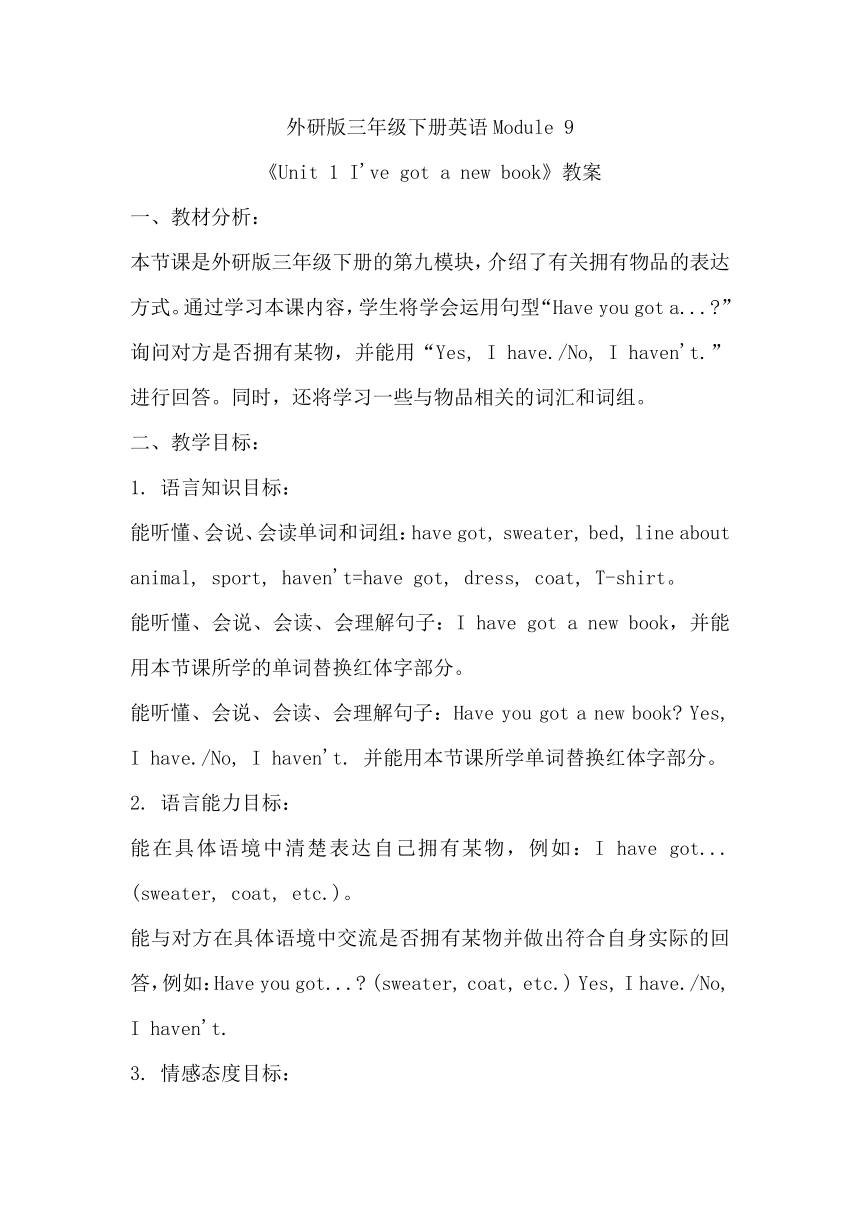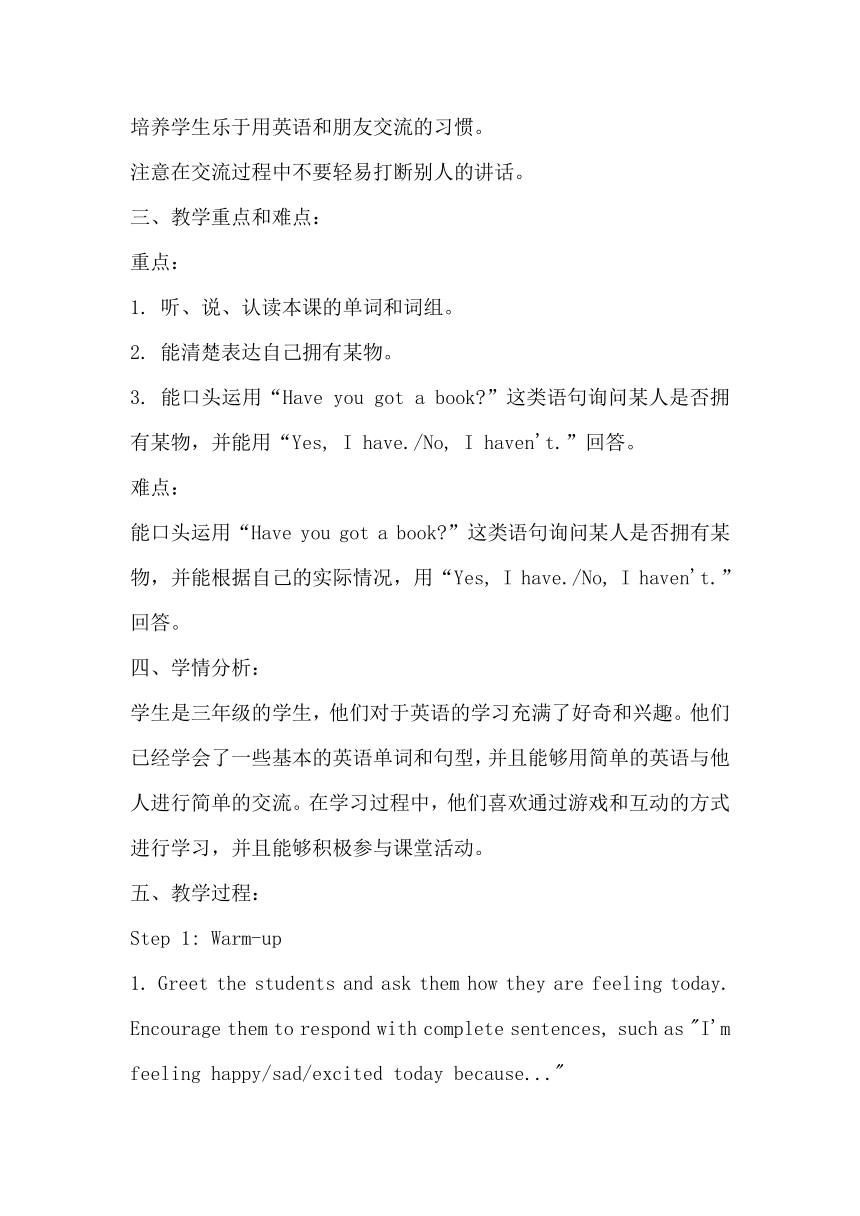Module 9 Unit 1 I've got a new book 教案
文档属性
| 名称 | Module 9 Unit 1 I've got a new book 教案 |  | |
| 格式 | docx | ||
| 文件大小 | 14.2KB | ||
| 资源类型 | 教案 | ||
| 版本资源 | 外研版(三年级起点) | ||
| 科目 | 英语 | ||
| 更新时间 | 2024-02-05 08:22:37 | ||
图片预览



文档简介
外研版三年级下册英语Module 9
《Unit 1 I've got a new book》教案
一、教材分析:
本节课是外研版三年级下册的第九模块,介绍了有关拥有物品的表达方式。通过学习本课内容,学生将学会运用句型“Have you got a... ”询问对方是否拥有某物,并能用“Yes, I have./No, I haven't.”进行回答。同时,还将学习一些与物品相关的词汇和词组。
二、教学目标:
1. 语言知识目标:
能听懂、会说、会读单词和词组:have got, sweater, bed, line about animal, sport, haven't=have got, dress, coat, T-shirt。
能听懂、会说、会读、会理解句子:I have got a new book,并能用本节课所学的单词替换红体字部分。
能听懂、会说、会读、会理解句子:Have you got a new book Yes, I have./No, I haven't. 并能用本节课所学单词替换红体字部分。
2. 语言能力目标:
能在具体语境中清楚表达自己拥有某物,例如:I have got... (sweater, coat, etc.)。
能与对方在具体语境中交流是否拥有某物并做出符合自身实际的回答,例如:Have you got... (sweater, coat, etc.) Yes, I have./No, I haven't.
3. 情感态度目标:
培养学生乐于用英语和朋友交流的习惯。
注意在交流过程中不要轻易打断别人的讲话。
三、教学重点和难点:
重点:
1. 听、说、认读本课的单词和词组。
2. 能清楚表达自己拥有某物。
3. 能口头运用“Have you got a book ”这类语句询问某人是否拥有某物,并能用“Yes, I have./No, I haven't.”回答。
难点:
能口头运用“Have you got a book ”这类语句询问某人是否拥有某物,并能根据自己的实际情况,用“Yes, I have./No, I haven't.”回答。
四、学情分析:
学生是三年级的学生,他们对于英语的学习充满了好奇和兴趣。他们已经学会了一些基本的英语单词和句型,并且能够用简单的英语与他人进行简单的交流。在学习过程中,他们喜欢通过游戏和互动的方式进行学习,并且能够积极参与课堂活动。
五、教学过程:
Step 1: Warm-up
1. Greet the students and ask them how they are feeling today. Encourage them to respond with complete sentences, such as "I'm feeling happy/sad/excited today because..."
2. Play a quick game of "Simon Says" to review some body parts vocabulary. Give instructions like "Simon says touch your head/shoulder/knee/toe." Make sure to use both positive and negative instructions to challenge the students.
Step 2: Presentation
1. Show a picture of a book and elicit the word "book" from the students. Write it on the board and emphasize the pronunciation.
2. Introduce the sentence pattern "I have got a new book" and explain its meaning. You can say, "When we want to talk about something we own or possess, we can use the sentence pattern 'I have got.' Today, we will use it to talk about new things we have."
3. Use gestures and facial expressions to convey the meaning of the sentence. For example, show excitement when saying "I have got a new book." Encourage the students to imitate your gestures and expressions.
4. Model the sentence and have the students repeat after you several times, focusing on correct pronunciation and intonation.
5. Show pictures of other objects (sweater, bed, etc.) and elicit the words from the students. Write the words on the board and make sure the students understand their meanings.
6. Model sentences using the new words, e.g., "I have got a new sweater/bed." Have the students repeat the sentences, emphasizing proper pronunciation and intonation.
Step 3: Practice
1. Divide the class into pairs or small groups.
2. Give each group a set of picture cards with different objects (book, sweater, bed, etc.).
3. Instruct the students to take turns asking and answering questions using the sentence pattern "Have you got a new... " and the vocabulary they have learned. For example, one student can ask, "Have you got a new book " and the other student can respond, "Yes, I have. It's very interesting!"
4. Monitor the groups and provide assistance as needed. Encourage the students to use complete sentences and to ask follow-up questions to extend the conversation.
5. After the practice, ask some pairs/groups to perform their dialogues in front of the class. Provide feedback and praise their efforts.
Step 4: Consolidation
1. Play a game of "What's Missing " with the vocabulary words written on the board.
2. Write a sentence on the board, but leave out one word. For example, write "I have got a new _____." and ask the students to guess the missing word. Allow the students to take turns guessing and encourage them to use the sentence pattern correctly.
3. Repeat the game with different sentences and words to reinforce the vocabulary and sentence structure. You can also ask the students to create their own sentences and challenge their classmates to fill in the missing word.
Step 5: Production
1. Ask the students to imagine they have a new item (e.g., a new toy) and to think about how they would describe it using the sentence pattern "I have got a new _____."
2. Give each student a piece of paper and ask them to draw a picture of their new item.
3. Instruct the students to write a sentence describing their new item using the sentence pattern. Encourage them to be creative and use descriptive words.
4. After the students have finished, encourage them to share their drawings and sentences with their classmates. They can take turns presenting their items to the class and using the sentence pattern to describe them.
Step 6: Wrap-up
1. Review the vocabulary and sentence patterns learned in the lesson. Ask the students questions like "What have you got " and "Have you got a new book "
2. Encourage the students to respond using complete sentences and provide positive feedback on their efforts.
3. Summarize the key points of the lesson, emphasizing the use of the sentence pattern "I have got" to talk about possessions.
4. Praise the students for their participation and effort throughout the lesson, and provide encouragement for their continued progress in learning English.
六、板书设计:
[Have you got a new... ]
I have got a new book/sweater/bed.
Yes, I have. / No, I haven't.
七、教学反思:
本节课通过引入新的词汇和句型,帮助学生学会用英语表达自己拥有某物,并能与他人进行简单的交流。学生在课堂上通过游戏和互动的形式积极参与,他们能够理解和运用所学内容,并能在实际情境中进行口头表达和回答。在以后的教学中,可以进一步扩展学生的词汇量和句型运用能力,让他们能够在更多的语境中进行交流和表达。
《Unit 1 I've got a new book》教案
一、教材分析:
本节课是外研版三年级下册的第九模块,介绍了有关拥有物品的表达方式。通过学习本课内容,学生将学会运用句型“Have you got a... ”询问对方是否拥有某物,并能用“Yes, I have./No, I haven't.”进行回答。同时,还将学习一些与物品相关的词汇和词组。
二、教学目标:
1. 语言知识目标:
能听懂、会说、会读单词和词组:have got, sweater, bed, line about animal, sport, haven't=have got, dress, coat, T-shirt。
能听懂、会说、会读、会理解句子:I have got a new book,并能用本节课所学的单词替换红体字部分。
能听懂、会说、会读、会理解句子:Have you got a new book Yes, I have./No, I haven't. 并能用本节课所学单词替换红体字部分。
2. 语言能力目标:
能在具体语境中清楚表达自己拥有某物,例如:I have got... (sweater, coat, etc.)。
能与对方在具体语境中交流是否拥有某物并做出符合自身实际的回答,例如:Have you got... (sweater, coat, etc.) Yes, I have./No, I haven't.
3. 情感态度目标:
培养学生乐于用英语和朋友交流的习惯。
注意在交流过程中不要轻易打断别人的讲话。
三、教学重点和难点:
重点:
1. 听、说、认读本课的单词和词组。
2. 能清楚表达自己拥有某物。
3. 能口头运用“Have you got a book ”这类语句询问某人是否拥有某物,并能用“Yes, I have./No, I haven't.”回答。
难点:
能口头运用“Have you got a book ”这类语句询问某人是否拥有某物,并能根据自己的实际情况,用“Yes, I have./No, I haven't.”回答。
四、学情分析:
学生是三年级的学生,他们对于英语的学习充满了好奇和兴趣。他们已经学会了一些基本的英语单词和句型,并且能够用简单的英语与他人进行简单的交流。在学习过程中,他们喜欢通过游戏和互动的方式进行学习,并且能够积极参与课堂活动。
五、教学过程:
Step 1: Warm-up
1. Greet the students and ask them how they are feeling today. Encourage them to respond with complete sentences, such as "I'm feeling happy/sad/excited today because..."
2. Play a quick game of "Simon Says" to review some body parts vocabulary. Give instructions like "Simon says touch your head/shoulder/knee/toe." Make sure to use both positive and negative instructions to challenge the students.
Step 2: Presentation
1. Show a picture of a book and elicit the word "book" from the students. Write it on the board and emphasize the pronunciation.
2. Introduce the sentence pattern "I have got a new book" and explain its meaning. You can say, "When we want to talk about something we own or possess, we can use the sentence pattern 'I have got.' Today, we will use it to talk about new things we have."
3. Use gestures and facial expressions to convey the meaning of the sentence. For example, show excitement when saying "I have got a new book." Encourage the students to imitate your gestures and expressions.
4. Model the sentence and have the students repeat after you several times, focusing on correct pronunciation and intonation.
5. Show pictures of other objects (sweater, bed, etc.) and elicit the words from the students. Write the words on the board and make sure the students understand their meanings.
6. Model sentences using the new words, e.g., "I have got a new sweater/bed." Have the students repeat the sentences, emphasizing proper pronunciation and intonation.
Step 3: Practice
1. Divide the class into pairs or small groups.
2. Give each group a set of picture cards with different objects (book, sweater, bed, etc.).
3. Instruct the students to take turns asking and answering questions using the sentence pattern "Have you got a new... " and the vocabulary they have learned. For example, one student can ask, "Have you got a new book " and the other student can respond, "Yes, I have. It's very interesting!"
4. Monitor the groups and provide assistance as needed. Encourage the students to use complete sentences and to ask follow-up questions to extend the conversation.
5. After the practice, ask some pairs/groups to perform their dialogues in front of the class. Provide feedback and praise their efforts.
Step 4: Consolidation
1. Play a game of "What's Missing " with the vocabulary words written on the board.
2. Write a sentence on the board, but leave out one word. For example, write "I have got a new _____." and ask the students to guess the missing word. Allow the students to take turns guessing and encourage them to use the sentence pattern correctly.
3. Repeat the game with different sentences and words to reinforce the vocabulary and sentence structure. You can also ask the students to create their own sentences and challenge their classmates to fill in the missing word.
Step 5: Production
1. Ask the students to imagine they have a new item (e.g., a new toy) and to think about how they would describe it using the sentence pattern "I have got a new _____."
2. Give each student a piece of paper and ask them to draw a picture of their new item.
3. Instruct the students to write a sentence describing their new item using the sentence pattern. Encourage them to be creative and use descriptive words.
4. After the students have finished, encourage them to share their drawings and sentences with their classmates. They can take turns presenting their items to the class and using the sentence pattern to describe them.
Step 6: Wrap-up
1. Review the vocabulary and sentence patterns learned in the lesson. Ask the students questions like "What have you got " and "Have you got a new book "
2. Encourage the students to respond using complete sentences and provide positive feedback on their efforts.
3. Summarize the key points of the lesson, emphasizing the use of the sentence pattern "I have got" to talk about possessions.
4. Praise the students for their participation and effort throughout the lesson, and provide encouragement for their continued progress in learning English.
六、板书设计:
[Have you got a new... ]
I have got a new book/sweater/bed.
Yes, I have. / No, I haven't.
七、教学反思:
本节课通过引入新的词汇和句型,帮助学生学会用英语表达自己拥有某物,并能与他人进行简单的交流。学生在课堂上通过游戏和互动的形式积极参与,他们能够理解和运用所学内容,并能在实际情境中进行口头表达和回答。在以后的教学中,可以进一步扩展学生的词汇量和句型运用能力,让他们能够在更多的语境中进行交流和表达。
同课章节目录
- Module 1
- Unit 1 It's the ABC song.
- Unit 2 My favourite colour is yellow.
- Module 2
- Unit 1 They are monkeys.
- Unit 2 The man is short.
- Module 3
- Unit 1 I like football.
- Unit 2 I don't like riding my bike.
- Module 4
- Unit 1 Do you like meat?
- Unit 2 Does Lingling like oranges?
- Module 5
- Unit 1 She goes to school on Mondays.
- Unit 2 Does your mum go to work on Saturdays?
- Module 6
- Unit 1 What do you do on Sundays?
- Unit 2 What does Lingling have at school?
- Module 7
- Unit 1 We fly kites in spring.
- Unit 2 It's warm today.
- Module 8
- Unit 1 It's on your desk.
- Unit 2 Daming flies a kite in the park.
- Module 9
- Unit 1 I've got a new book.
- Unit 2 Has Amy got a bike?
- Review Module
- Unit 1
- Unit 2
- Module 10
- Unit 1 Here's a red hat.
- Unit 2 She's got an orange sweater.
